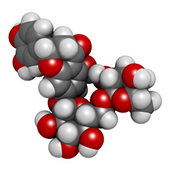30-10-2017
Hesperidin methyl chalcone, a powerful protector?
 Behind the scientific name hesperidin methyl chalcone lies a powerful active principle. In May, we reported on its natural benefits for the cardiovascular system. In fact, its therapeutic potential has been shown to be much more extensive. Studies conducted over recent years suggest that hesperidin methyl chalcone offers benefits for the prevention and treatment of a number of health problems. Read on to find out more about the protective effects of hesperidin methyl chalcone.
Behind the scientific name hesperidin methyl chalcone lies a powerful active principle. In May, we reported on its natural benefits for the cardiovascular system. In fact, its therapeutic potential has been shown to be much more extensive. Studies conducted over recent years suggest that hesperidin methyl chalcone offers benefits for the prevention and treatment of a number of health problems. Read on to find out more about the protective effects of hesperidin methyl chalcone.
Protective effects for maintaining cardiovascular health
To recap, our previous article on hesperidin methyl chalcone focused on its cardio-protective effects. A study published in The Journal of Clinical Endocrinology & Metabolism1 had confirmed the compound’s vasodilatory action, showing that the activity of hesperidin methyl chalcone helped prevent certain cardiovascular problems such as hypertension. In another study, published in the specialist journal Experimental and Toxicologic Pathology2, hesperidin methyl chalcone had been shown to have lipid-lowering effects and thus improve the lipid profile. Finally, several studies had demonstrated its antioxidant potency and cardio-protective potential3.
Photo-protective action for fighting the effects of UVB radiation
In addition to its benefits for cardiovascular health, hesperidin methyl chalcone has also been studied for its antioxidant power and ability to combat the harmful effects of ultraviolet radiation. Scientists evaluated this photo-protective activity by administering hesperidin methyl chalcone to UVB-irradiated mice. Published in the Journal of Photochemistry and Photobiology B: Biology4, the results of this study revealed a number of beneficial effects. The hesperidin methyl chalcone treatment was found to inhibit several processes linked to UVB exposure: skin oedema, neutrophil recruitment, and matrix metalloproteinase-9 activity. The researchers also found it had a powerful antioxidant effect which reduced free radical generation. Their results suggest this compound could also offer anti-inflammatory effects for inhibiting pro-inflammatory mediator synthesis.
Anti-inflammatory and analgesic properties
Hesperidin methyl chalcone’s anti-inflammatory activity, mentioned above, together with its analgesic potential, was demonstrated in another study conducted on mice. Published in the journal Chemico-Biological Interactions5, this research confirmed the potential of hesperidin methyl chalcone to reduce inflammatory pain and fight inflammatory reactions. It also shed light on its mechanism of action, suggesting that it acts on specific cell receptors called TRPV1. These are known to affect pain mechanisms, oxidative stress, production of inflammatory cytokines and activity of the transcription factor NF-κB. This research also found an absence of side-effects from the use of hesperidin methyl chalcone.
Together, these studies confirm the therapeutic potential of the active principle hesperidin methyl chalcone, one of the venotonics available from the SuperSmart catalogue. Current scientific data suggests this molecule offers various health-protective effects as a result of its antioxidant, anti-inflammatory and analgesic properties.
> Sources : 1. S Rizza, Citrus polyphenol hesperidin stimulates production of nitric oxide in endothelial cells while improving endothelial function and reducing inflammatory markers in patients with metabolic syndrome, The Journal of Clinical Endocrinology & Metabolism, Mai 2011;96(5):E782-92.
2. P Selvaraj, KV Pugalendi, Efficacy of hesperidin on plasma, heart and liver tissue lipids in rats subjected to isoproterenol-induced cardiotoxicity, Experimental and Toxicologic Pathology, Juillet 2012;64(5):449-52.
3. P Selvaraj, KV Pugalendi, Hesperidin, a flavanone glycoside, on lipid peroxidation and antioxidant status in experimental myocardial ischemic rats, Redox Reports, 2010;15(5):217-223.
4. RM Martinez, et al., Hesperidin methyl chalcone inhibits oxidative stress and inflammation in a mouse model of ultraviolet B irradiation-induced skin damage, The Journal of Photochemistry and Photobiology B: Biology, Juillet 2015;148:145-153.
5. FA Pinho-Ribeiro, et al., Protective effects of the flavonoid hesperidin methyl chalcone in inflammation and pain in mice: role of TRPV1, oxidative stress, cytokines and NF-κB, Chemico-Biological Interactions, 25 février 2015;228:88-99.
Order the nutrient mentioned in this article
Further reading
07-06-2016
Imagine a nutrient that could prevent wrinkles, slackening and ageing of the skin, not just on the face (eyelids, cheeks, lips) but also on the...
Read more24-06-2019
Better known as PEA, palmitoylethanolamide is a natural and powerful active principle discovered in 1957. Since then, it has consistently been the subject of new...
Read more22-05-2017
An Indian research team has just made a surprising discovery in relation to the accumulation of ‘bad’ cholesterol in the arteries 1 ; a combination...
Read more© 1997-2024 Fondation pour le Libre Choix
All rights reserved
All rights reserved
Free
Thank you for visiting our site. Before you go
REGISTER WITHClub SuperSmart
And take advantage
of exclusive benefits:
of exclusive benefits:
- Free: our weekly science-based newsletter "Nutranews"
- Special offers for club members only


















